Unit 2 Wildlife Protection Reading and Thinking 课件(共32张PPT,内镶嵌视频)-高中英语人教版(2019)必修第二册
文档属性
| 名称 | Unit 2 Wildlife Protection Reading and Thinking 课件(共32张PPT,内镶嵌视频)-高中英语人教版(2019)必修第二册 | 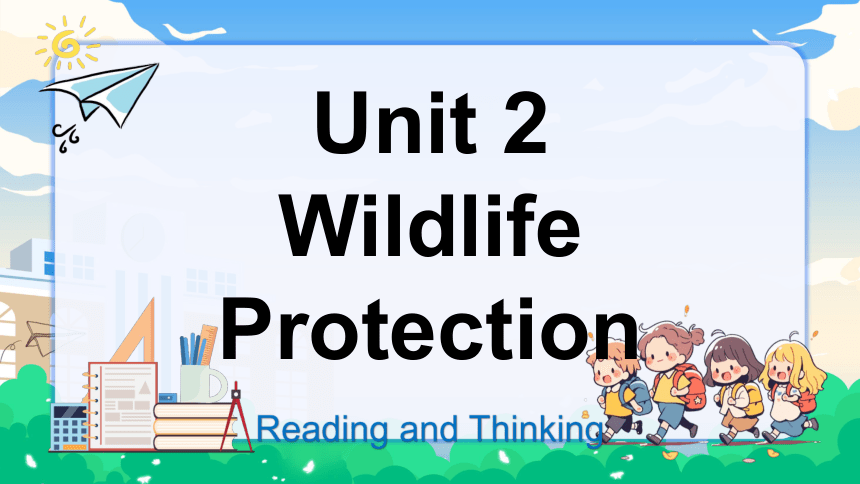 | |
| 格式 | pptx | ||
| 文件大小 | 22.6MB | ||
| 资源类型 | 教案 | ||
| 版本资源 | 人教版(2019) | ||
| 科目 | 英语 | ||
| 更新时间 | 2025-05-29 09:32:09 | ||
图片预览

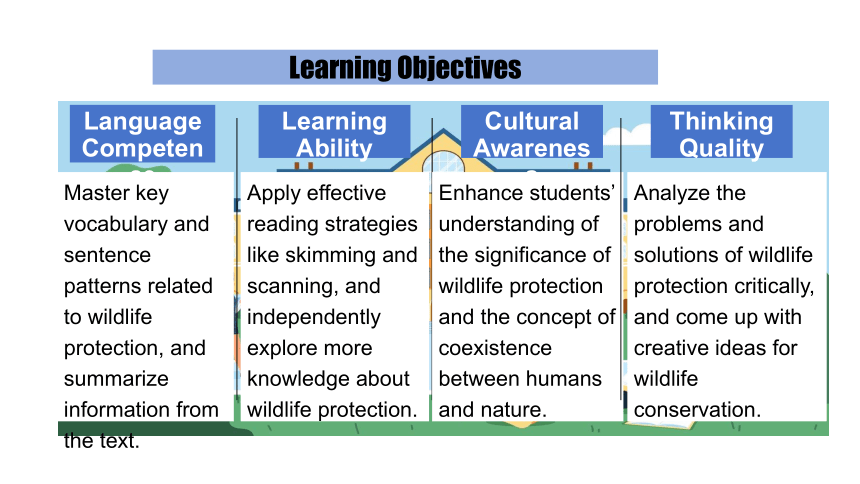
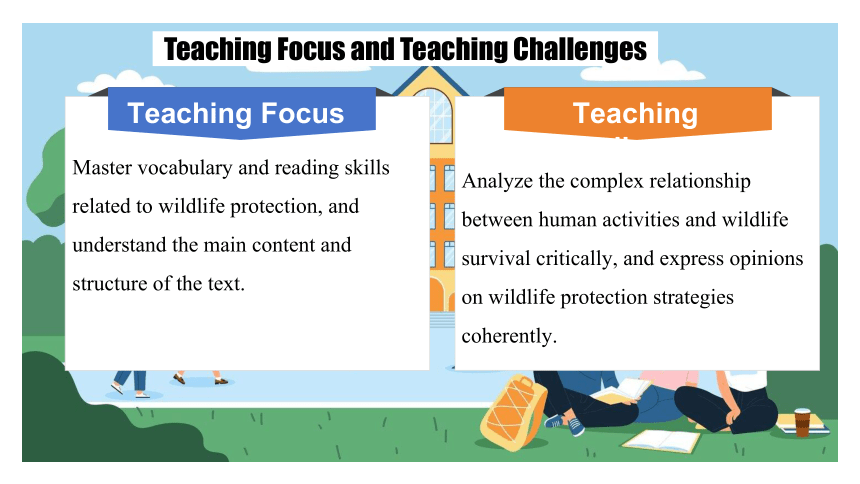


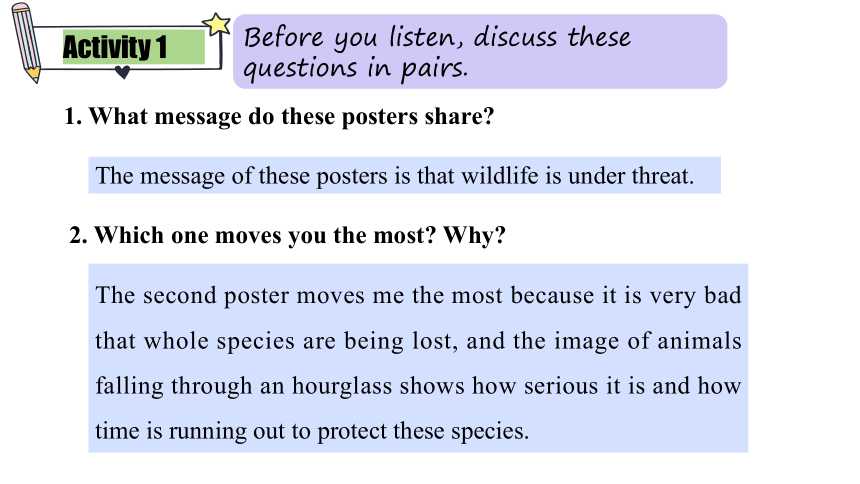
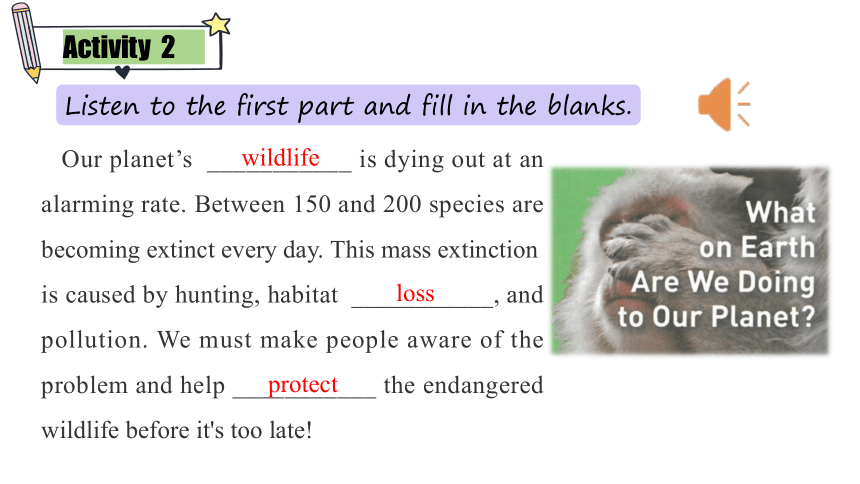


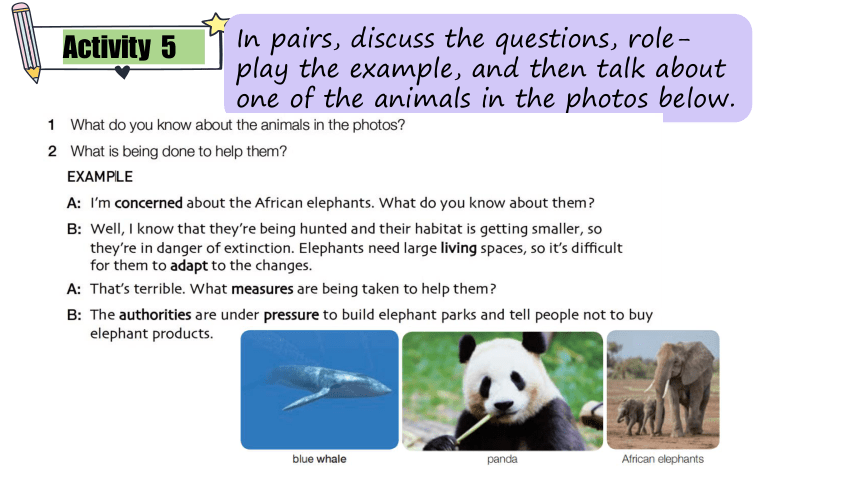

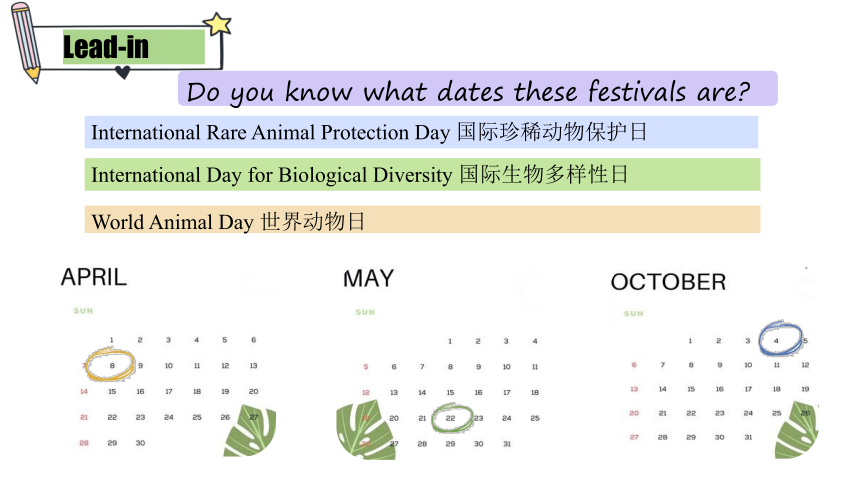
文档简介
(共32张PPT)
Unit 2
Wildlife Protection
Reading and Thinking
Language Competence
Master key vocabulary and sentence patterns related to wildlife protection, and summarize information from the text.
Learning Ability
Apply effective reading strategies like skimming and scanning, and independently explore more knowledge about wildlife protection.
Cultural Awareness
Enhance students’ understanding of the significance of wildlife protection and the concept of coexistence between humans and nature.
Thinking Quality
Analyze the problems and solutions of wildlife protection critically, and come up with creative ideas for wildlife conservation.
Learning Objectives
Teaching Focus
Master vocabulary and reading skills related to wildlife protection, and understand the main content and structure of the text.
Teaching Challenges
Analyze the complex relationship between human activities and wildlife survival critically, and express opinions on wildlife protection strategies coherently.
Teaching Focus and Teaching Challenges
Part 1
Listening & Speaking
Activity 1
Before you listen, discuss these questions in pairs.
1. What message do these posters share
2. Which one moves you the most Why
Activity 1
Before you listen, discuss these questions in pairs.
1. What message do these posters share
2. Which one moves you the most Why
The message of these posters is that wildlife is under threat.
The second poster moves me the most because it is very bad that whole species are being lost, and the image of animals falling through an hourglass shows how serious it is and how time is running out to protect these species.
Activity 2
Listen to the first part and fill in the blanks.
Our planet’s ___________ is dying out at an alarming rate. Between 150 and 200 species are becoming extinct every day. This mass extinction is caused by hunting, habitat ___________, and pollution. We must make people aware of the problem and help ___________ the endangered wildlife before it's too late!
protect
wildlife
loss
Activity 3
Listen to the second part and answer the questions.
1. How many elephants are killed on average every day
2. What did Prince William say about China
54.
A. China has made a lot of progress.
B. China can become a global leader in wildlife protection.
C. China preserves its natural habitats well.
Activity 4
Discuss the question in groups.
What does “Change begins with you” mean
It means that if we want things to change, we must change ourselves first and not wait for others to change first. We must be the change we want to see in the world.
Activity 5
In pairs, discuss the questions, role-play the example, and then talk about one of the animals in the photos below.
Part 2
Reading
Lead-in
Do you know what dates these festivals are
International Rare Animal Protection Day 国际珍稀动物保护日
International Day for Biological Diversity 国际生物多样性日
World Animal Day 世界动物日
1. What type of passage is it
A. Argumentation
B. Description
C. Journal
2. What's the main idea of the text
A. The Changtang National Nature Reserve.
B. The protection of the Tibetan antelopes.
C. Snow-covered mountains.
D. Some effective measures.
Look at the pictures below. What do you think the text is about
What do you know about the Tibetan antelope and the Changtang National Nature Reserve
The Tibetan antelope was an endangered animal, but because of human action to protect it, its numbers are now recovering.
The Changtang National Nature Reserve is in western China and covers an area of about 120,000 square miles. It was created to protect the area and the wildlife that live there.
Para.1-2
Para.7
Para.3-6
What I see
What I hear
What I think
Skimming for the structure of the passage.
Skimming for the main idea of the each paragraph.
Paragraph 1
Paragraph 2
Paragraph 3
Paragraph 4
Paragraph 5
Paragraph 6
Paragraph 7
Tibetan antelopes are in danger
The good effects the measures have had
The bad times for the Tibetan antelope
To observe Tibetan antelopes
The guide, Zhaxi, and the Changtang National Reserve
We should learn to exist in harmony with nature
Measures were taken to save this species from extinction
Read the 1st part and find the information.
thin
snow - covered mountains
thin
graceful animals
the plains
their valuable fur
Read the 2nd part and find the information.
Introduction 1. Guide: Zhaxi from Changtang
2. Workplace: __________________________
3. Significance: Shelter for NW Tibet's wildlife; Sacred land, wildlife protection as lifestyle
Problem 1. Time: ____________
2. Issue: Tibetan antelope population dropped by more than 50%:
① _________________________________ ;
②______________________________________________________________
Measures 1. Government: _________________________
2. Volunteers: ______________________________
3. ______________________
Results 1. _____________________________
2. ________________________________________________
Changtang National Nature Reserve
1980s - 1990s
Hunters were shooting antelopes to make profits
Their habitats were becoming smaller as new roads and railways were built.
placed it under national protection
watched over the antelopes day and night
Bridges and gates were added
The antelope population has recovered
The Tibetan antelope was removed from the endangered species list
Read the 3rd part and find the information.
In the evening, I drink a cup of tea and watch the stars. I think about the antelopes and what Zhaxi told me. Much is being done to protect wildlife, but if we really want to save the planet, we must change our way of life. Only when we learn to exist in harmony with nature can we stop being a threat to wildlife and to our planet.
Why does the author think we need to change our way of life if we want to save the planet
Because only when we change our way of life and learn to exist in harmony with nature can we stop being a threat to wildlife and to our planet.
Enjoy the video.
Read the sentences below, and decide if each idea is the literal meaning (L)of the text or only implied (l) by the text.
I The Tibetan antelope lives high above sea level.
(This is implied by “The air is thin”)
____When they first saw the antelopes, they were very far away.
____We should not buy goods made from endangered animals.
____Human activities are threatening animals and plants.
____The Tibetan antelope is not an endangered species now.
L
I
(“make out”)
(“Hunters were shooting to make profit”)
(“the threats … have not yet disappeared”)
(“…was removed …”)
L
I
Herds of elephants used to live on the ________ of Africa and in the forests of Asia. But today, they face a serious _____________from ___________. These large animals are being killed _________for their body parts that are considered valuable. In order to save them, some countries have created __________ where they can live in peace and safety. However, the ____________ on them will continue as long as interest in buying elephant products ________. To achieve _________ between humans and animals, the world must protect these beautiful creatures.
Learn about elephants by reading and completing the passage with the correct forms of the words.
hunters
illegally
reserve
threat
exist
plain
harmony
attacks
hunter
illegally
reserve
attack
exist
plain
harmony
threat
Part 3
Language Points
aware adj.知道;发觉;有……意识的
be/become aware of 知道;明白;意识到
be/become aware that... 明白……;意识到……
as far as I'm aware 据我所知
unaware adj.不知道的,未意识到的,不注意的
awareness n.察觉,觉悟,意识
make someone aware of 使某人意识到
练习:The campaign aims to raise public _________ about mental health issues.
awareness
average n. 平均数; 平均水平
adj.平均的; 正常的;普通的
vt.平均为; 计算出……的平均数
on average 平均;通常
above/below average 高于/低于平均水平
average out 平均为;算出…… 的平均数
averagely adv.一般地;平均地
averageness n.普通;平均状态
average-sized adj.中等大小的
练习:On ________, people spend about two hours a day on social media.
average
concern vt.涉及;让……担忧
n.担心;忧虑
be/show/express concern about/for 对……表示关心/担心
concerned adj.担心的;关切的;相关的
be concerned about/for 担心……;关心……
as far as... be concerned 就……而言;依……之见
be concerned with 与……有关,涉及
concerning prep.关于;有关
练习:Many parents are _________ about their children’s online safety.
concerned
adapt vi.适应 vt.使适应;使适合
adapt oneself to 使自己适应或习惯于
adapt sth. to 使某物适应或适合于
adapt to 适应
adapt sth. for sth. 为某目的改编 / 改造某物
adapt...from... 根据……改编或改写……
adaptation n. 适应;改编作品
adaptable adj.能适应的;适应性强的
练习:The film is a successful _________ of the classic novel.
adaptation
remind vt. 提醒;使想起
remind sb. of/about sb./sth. 使某人想起(类似的人或物)
remind sb. to do sth. 提醒某人做某事
remind (sb.) that/how/what... 提醒(某人)……
reminder n. 提醒……的东西;(告知该做某事的)通知单
gentle reminder 委婉的提醒)
serve as a reminder 作为提醒)
练习:Don’t forget _________ him to submit the report on time.
to remind
Part 4
Exercise
Sample
1. Set a _________ (remind) on your phone so you don’t miss the flight.
2. A good leader should be ___________ (adapt) to changing circumstances.
3. Please _______ (提醒;使想起) me of the meeting time tomorrow.
4. The committee expressed serious _________ (担心;忧虑) about the budget cuts for education.
5. She made me _______ (知道;发觉) of the importance of wildlife protection.
6. The __________ (adapt) process to living alone can be challenging for some people.
reminder
adaptable
remind
adaptation
averagely
concern
Homework
1. Summarise what we have learnt in this lesson;
2. Prepare for the next lesson
See you next time!
Unit 2
Wildlife Protection
Reading and Thinking
Language Competence
Master key vocabulary and sentence patterns related to wildlife protection, and summarize information from the text.
Learning Ability
Apply effective reading strategies like skimming and scanning, and independently explore more knowledge about wildlife protection.
Cultural Awareness
Enhance students’ understanding of the significance of wildlife protection and the concept of coexistence between humans and nature.
Thinking Quality
Analyze the problems and solutions of wildlife protection critically, and come up with creative ideas for wildlife conservation.
Learning Objectives
Teaching Focus
Master vocabulary and reading skills related to wildlife protection, and understand the main content and structure of the text.
Teaching Challenges
Analyze the complex relationship between human activities and wildlife survival critically, and express opinions on wildlife protection strategies coherently.
Teaching Focus and Teaching Challenges
Part 1
Listening & Speaking
Activity 1
Before you listen, discuss these questions in pairs.
1. What message do these posters share
2. Which one moves you the most Why
Activity 1
Before you listen, discuss these questions in pairs.
1. What message do these posters share
2. Which one moves you the most Why
The message of these posters is that wildlife is under threat.
The second poster moves me the most because it is very bad that whole species are being lost, and the image of animals falling through an hourglass shows how serious it is and how time is running out to protect these species.
Activity 2
Listen to the first part and fill in the blanks.
Our planet’s ___________ is dying out at an alarming rate. Between 150 and 200 species are becoming extinct every day. This mass extinction is caused by hunting, habitat ___________, and pollution. We must make people aware of the problem and help ___________ the endangered wildlife before it's too late!
protect
wildlife
loss
Activity 3
Listen to the second part and answer the questions.
1. How many elephants are killed on average every day
2. What did Prince William say about China
54.
A. China has made a lot of progress.
B. China can become a global leader in wildlife protection.
C. China preserves its natural habitats well.
Activity 4
Discuss the question in groups.
What does “Change begins with you” mean
It means that if we want things to change, we must change ourselves first and not wait for others to change first. We must be the change we want to see in the world.
Activity 5
In pairs, discuss the questions, role-play the example, and then talk about one of the animals in the photos below.
Part 2
Reading
Lead-in
Do you know what dates these festivals are
International Rare Animal Protection Day 国际珍稀动物保护日
International Day for Biological Diversity 国际生物多样性日
World Animal Day 世界动物日
1. What type of passage is it
A. Argumentation
B. Description
C. Journal
2. What's the main idea of the text
A. The Changtang National Nature Reserve.
B. The protection of the Tibetan antelopes.
C. Snow-covered mountains.
D. Some effective measures.
Look at the pictures below. What do you think the text is about
What do you know about the Tibetan antelope and the Changtang National Nature Reserve
The Tibetan antelope was an endangered animal, but because of human action to protect it, its numbers are now recovering.
The Changtang National Nature Reserve is in western China and covers an area of about 120,000 square miles. It was created to protect the area and the wildlife that live there.
Para.1-2
Para.7
Para.3-6
What I see
What I hear
What I think
Skimming for the structure of the passage.
Skimming for the main idea of the each paragraph.
Paragraph 1
Paragraph 2
Paragraph 3
Paragraph 4
Paragraph 5
Paragraph 6
Paragraph 7
Tibetan antelopes are in danger
The good effects the measures have had
The bad times for the Tibetan antelope
To observe Tibetan antelopes
The guide, Zhaxi, and the Changtang National Reserve
We should learn to exist in harmony with nature
Measures were taken to save this species from extinction
Read the 1st part and find the information.
thin
snow - covered mountains
thin
graceful animals
the plains
their valuable fur
Read the 2nd part and find the information.
Introduction 1. Guide: Zhaxi from Changtang
2. Workplace: __________________________
3. Significance: Shelter for NW Tibet's wildlife; Sacred land, wildlife protection as lifestyle
Problem 1. Time: ____________
2. Issue: Tibetan antelope population dropped by more than 50%:
① _________________________________ ;
②______________________________________________________________
Measures 1. Government: _________________________
2. Volunteers: ______________________________
3. ______________________
Results 1. _____________________________
2. ________________________________________________
Changtang National Nature Reserve
1980s - 1990s
Hunters were shooting antelopes to make profits
Their habitats were becoming smaller as new roads and railways were built.
placed it under national protection
watched over the antelopes day and night
Bridges and gates were added
The antelope population has recovered
The Tibetan antelope was removed from the endangered species list
Read the 3rd part and find the information.
In the evening, I drink a cup of tea and watch the stars. I think about the antelopes and what Zhaxi told me. Much is being done to protect wildlife, but if we really want to save the planet, we must change our way of life. Only when we learn to exist in harmony with nature can we stop being a threat to wildlife and to our planet.
Why does the author think we need to change our way of life if we want to save the planet
Because only when we change our way of life and learn to exist in harmony with nature can we stop being a threat to wildlife and to our planet.
Enjoy the video.
Read the sentences below, and decide if each idea is the literal meaning (L)of the text or only implied (l) by the text.
I The Tibetan antelope lives high above sea level.
(This is implied by “The air is thin”)
____When they first saw the antelopes, they were very far away.
____We should not buy goods made from endangered animals.
____Human activities are threatening animals and plants.
____The Tibetan antelope is not an endangered species now.
L
I
(“make out”)
(“Hunters were shooting to make profit”)
(“the threats … have not yet disappeared”)
(“…was removed …”)
L
I
Herds of elephants used to live on the ________ of Africa and in the forests of Asia. But today, they face a serious _____________from ___________. These large animals are being killed _________for their body parts that are considered valuable. In order to save them, some countries have created __________ where they can live in peace and safety. However, the ____________ on them will continue as long as interest in buying elephant products ________. To achieve _________ between humans and animals, the world must protect these beautiful creatures.
Learn about elephants by reading and completing the passage with the correct forms of the words.
hunters
illegally
reserve
threat
exist
plain
harmony
attacks
hunter
illegally
reserve
attack
exist
plain
harmony
threat
Part 3
Language Points
aware adj.知道;发觉;有……意识的
be/become aware of 知道;明白;意识到
be/become aware that... 明白……;意识到……
as far as I'm aware 据我所知
unaware adj.不知道的,未意识到的,不注意的
awareness n.察觉,觉悟,意识
make someone aware of 使某人意识到
练习:The campaign aims to raise public _________ about mental health issues.
awareness
average n. 平均数; 平均水平
adj.平均的; 正常的;普通的
vt.平均为; 计算出……的平均数
on average 平均;通常
above/below average 高于/低于平均水平
average out 平均为;算出…… 的平均数
averagely adv.一般地;平均地
averageness n.普通;平均状态
average-sized adj.中等大小的
练习:On ________, people spend about two hours a day on social media.
average
concern vt.涉及;让……担忧
n.担心;忧虑
be/show/express concern about/for 对……表示关心/担心
concerned adj.担心的;关切的;相关的
be concerned about/for 担心……;关心……
as far as... be concerned 就……而言;依……之见
be concerned with 与……有关,涉及
concerning prep.关于;有关
练习:Many parents are _________ about their children’s online safety.
concerned
adapt vi.适应 vt.使适应;使适合
adapt oneself to 使自己适应或习惯于
adapt sth. to 使某物适应或适合于
adapt to 适应
adapt sth. for sth. 为某目的改编 / 改造某物
adapt...from... 根据……改编或改写……
adaptation n. 适应;改编作品
adaptable adj.能适应的;适应性强的
练习:The film is a successful _________ of the classic novel.
adaptation
remind vt. 提醒;使想起
remind sb. of/about sb./sth. 使某人想起(类似的人或物)
remind sb. to do sth. 提醒某人做某事
remind (sb.) that/how/what... 提醒(某人)……
reminder n. 提醒……的东西;(告知该做某事的)通知单
gentle reminder 委婉的提醒)
serve as a reminder 作为提醒)
练习:Don’t forget _________ him to submit the report on time.
to remind
Part 4
Exercise
Sample
1. Set a _________ (remind) on your phone so you don’t miss the flight.
2. A good leader should be ___________ (adapt) to changing circumstances.
3. Please _______ (提醒;使想起) me of the meeting time tomorrow.
4. The committee expressed serious _________ (担心;忧虑) about the budget cuts for education.
5. She made me _______ (知道;发觉) of the importance of wildlife protection.
6. The __________ (adapt) process to living alone can be challenging for some people.
reminder
adaptable
remind
adaptation
averagely
concern
Homework
1. Summarise what we have learnt in this lesson;
2. Prepare for the next lesson
See you next time!
